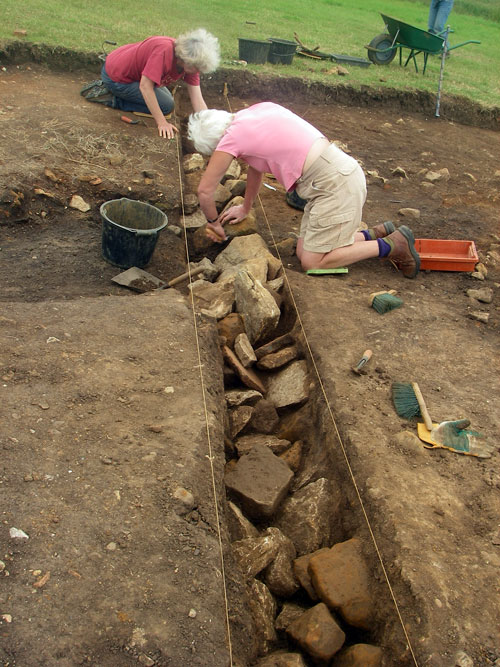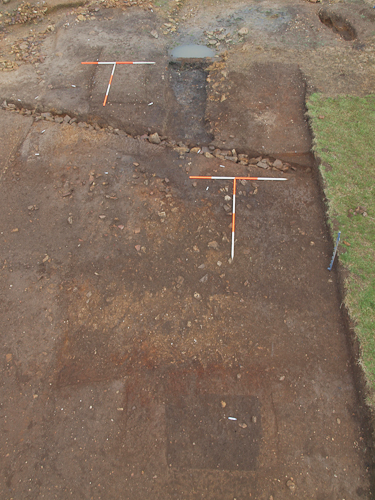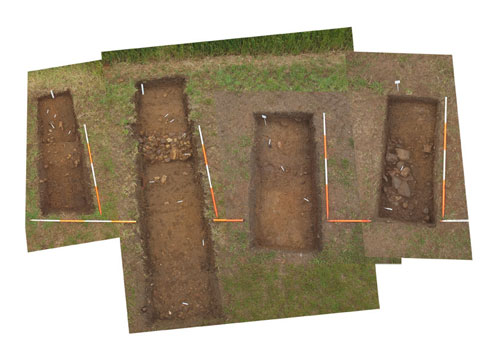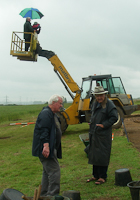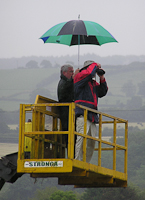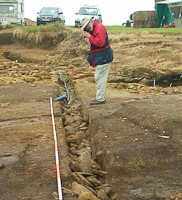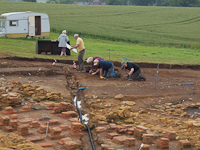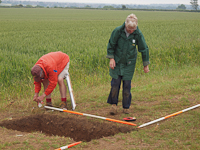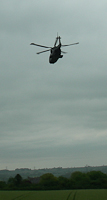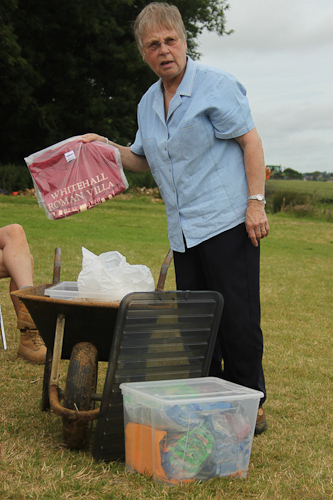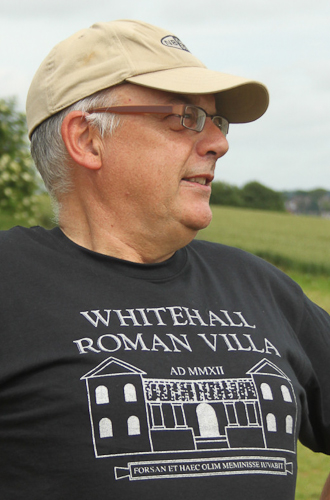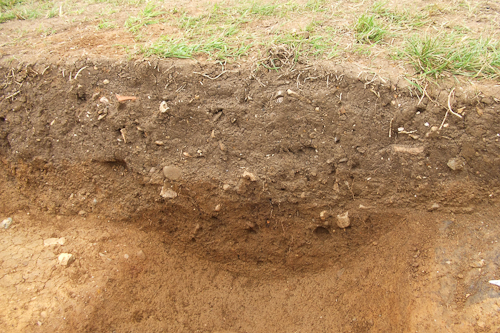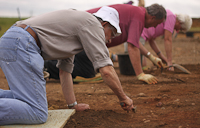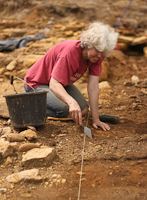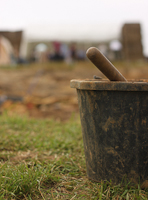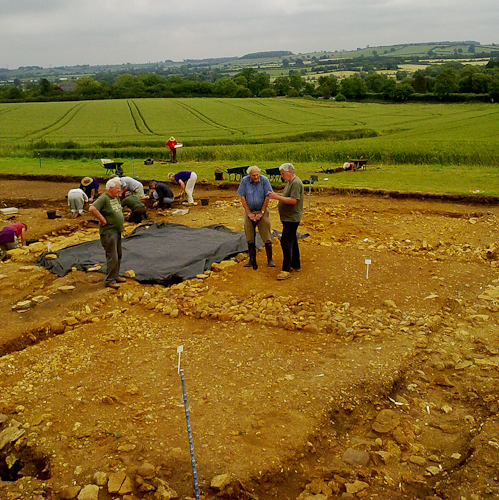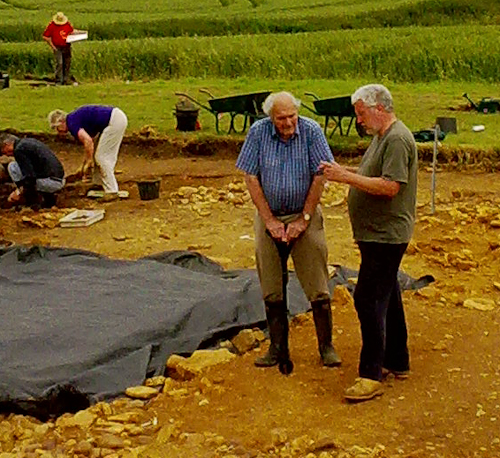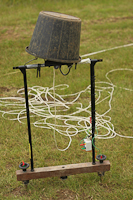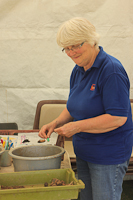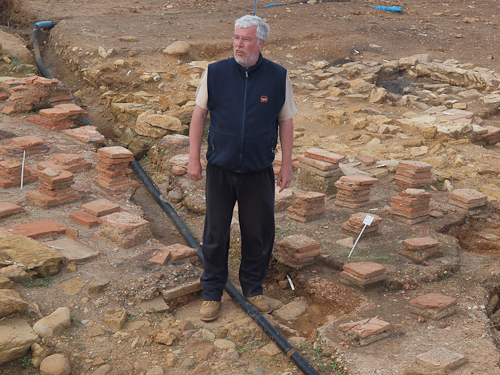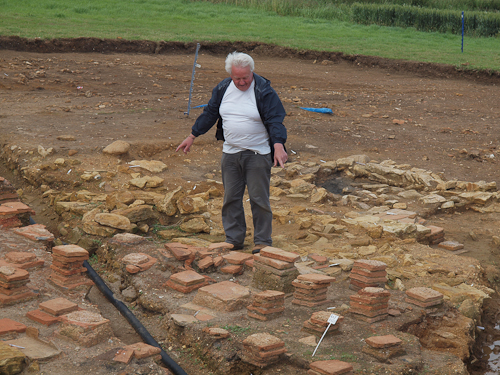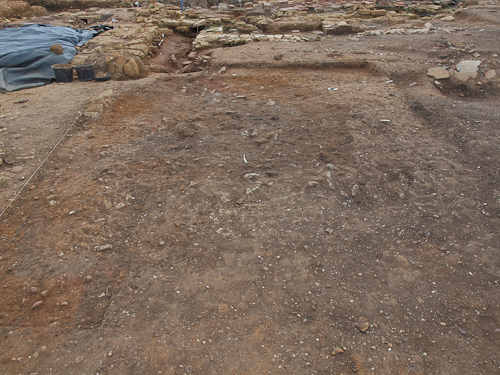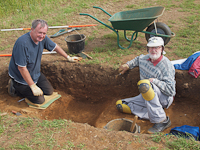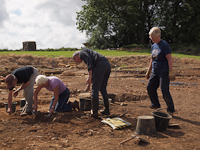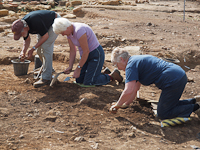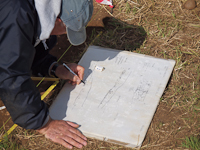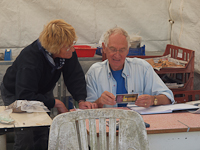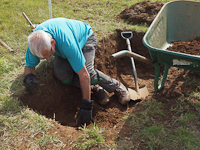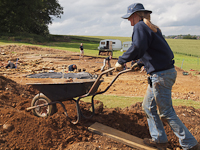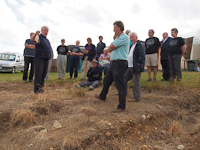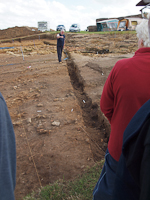 |
|
|||||
|
|
AN OCCASIONAL PROGRESS REPORT WEEK 3 |
|||||
Day 11 of 20: Monday 25 June No photos today, but I went up to the site after end of play for the CLASP Organising Committee meeting. The big diagonal drain has now been excavated right up to the northern baulk - I understand that nothing untoward was found. Meanwhile the careful taking back/down of the nail-strewn "industrial" area continues. This is, of course, the area where iron oxide was found and analysed last year. More soon. |
||||||
Day 12 of 20: Tuesday 26 June Dampish when I arrived on site at 14.30.
But it cleared up enough for the excavation of the diagonal drain to be comlpeted:
I spent a jolly while photographing from the cage on the Matbro driven brilliantly as ever by Richard. Steve came up with me to hold the umbrella (to keep the cameras dry, not me!). I think he had a bit of a look around as well. (Photos on the right by Ruth and Fred - thanks. Rain coat by Beryl). By the way - I left my brollie up there on the northern baulk. If you rescued it, thanks! Here's a view of the northend of the site - click on it for a bigger version: We also shot each of the test pits from right overhead (as far as possible). Here I've lined them up using the string and rods Fred and I put down. I've sized the photos using the horizontl ranging rods as a guide - the vertical ones look different in length because they are different distances from the camera - and different angles slightly. These things are always a bit of compromise, but I think a composite shot like this has its uses - again, click on it for a bigger version. I then photographed everything again from the ground and shot the north end of the diagonal drain in small lengths. Once I'd finished, the job of planning the drain began:
I don't envy them that job! |
|
|||||
Day 13 of 20: Wednesday 27 June All photos by Chris Wiggins - thanks Chris. Chris wrote this: One change for today, following one of Steve's meetings the 4x pits (A-D) have now been officially reclassified - they are no longer to be called "test pits" but now are "trial trenches". (OK, so the pits have been upgraded - posh eh?) A dry day with much progress made. A number of Roman nails are sill coming out much to the delight of the Small Finds team.
CORRECTION: a little bird just put me right - Beryl is trying to sell old T-shirts above. The new ones are...
...black... ... and last week Gillian sent me this: The t-shirts arrived today.
The caption is: Chris' photos are excellent as always, so I've put them in a gallery where you can admire them at a good size. CLICK HERE. And a late entry from Malcolm: I was working in Trial Trench C trying to find the profile of the foundation trench of the suspected boundary wall. In case any one is interested, here is a photo of mine showing the result.
|
|
|||||
|
Day 14 of 20: Thursday 28 June This photo from Ruth...
Chris sent me another fine set of photos - many of them feature the hardware of digging, and there are lovely people shots too. CLICK HERE.
|
Photos © Chris Wiggins
|
|||||
Day 15 of 20: Friday 29 June A fine day, but a bit windy. Please welcome to the blog Trial Trenches E and F (straight to trial trench status, you notice - no limbo as pits). They were dug after Fred surveyed the area with the resistivity meter, trying to pin down any further remnants of the eastern wall. F has a long way to go yet, but E is finished:
Some debris, but not the hoped for return of the eastern wall. The big news of the day is the finding of Whitehall's first piece of pottery with writing on it:
Yes, it's an R - possibly the answer to life, the universe and everything, if a West Country one. The site tour was notable for quite a few statements that "there's a lot going on there", and I should warn you that it's getting harder and harder to convey the messages without video or incredibly complex 3D graphics. The reason is that the interpretation (often speculative) is now all about phasing and things going on more or less invisibly under other things (a bit like banking - only honest, of course). Anyway here goes for a very dumbed-down version (well I used to work for the BBC, so what else can you possibly expect?!). Steve explained that we have found three internal walls running E-W underneath the hypocaust area (room 3) - one of them is just... . ...here. So there were at least two rooms underlying room 3, and here is Steve standing on the paving stone floor of those earlier phase, lower rooms....
Dave was sent off to indicate two butresses associated with those walls...
The drain between rooms 5 and 7 ...
.. is proving interesting, with a drain pipe showing, on the south facing side, running north-south under room 7...
... and post holes running along the north facing side of the drain...
Quite what the upright stones between the post holes are for is a mystery at present. More work to be done on this drain next week. The area east of this drain has be worked back to show that there are no structures here.
But there was a lot of building debris and pottery (including the R sherd shown above), and you can see quite clearly (honest) where the drain extends through the area - it comes towards the camera veering to the right (photo above). Its been established that there are no structures in the northern quarter of the site either...
... but there is evidence of drains, and some interesting coloured patches that need futher investigation (sorry if I'm sounding a bit desperate here! Should be clearer next week!). Next week (the last already) will have four days of detailed work targetted at answering specific questions here and there. Enjoy the weekend.
|
|
|||||
| ||||||

